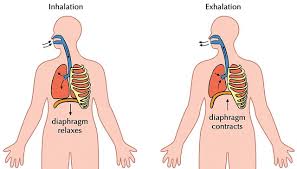What is the difference between inhalation and exhalation?
Breathing is a process that takes place in the lungs. It normally entails inhalation and exhalation. Therefore, the process of inhalation and exhalation tends to vary from one person to another.
The article provides a detailed insight into the core difference between inhalation and exhalation. It is worth reading through it in order to the similarities between inhalation and exhalation besides their differences.

What Is Inhalation?
Inhalation is a basic process of breathing in air containing a large amount of oxygen into the lungs. The process is also known as inspiration.
Research shows that inspiration is quite important both for human beings and animal life. The process entails the contraction of the diaphragm and relaxation of intercostal muscles.
The contraction and relaxation result in the creation of a slight vacuum that causes a decrease in air pressure in the lungs. Fresh air then moves into the lungs through the nostril to fill the space.
What Is Exhalation?
Exhalation is another basic process of breathing out air containing a large amount of carbon dioxide from the body. The breathing process is also known as expiration.
Research shows that excessive accumulation of carbon dioxide in the body of animals and humans have a negative impact on their health.
The relaxation and contraction of both diaphragm and intercostal muscles enable the body to expel out air containing carbon dioxide.
Comparison Chart: Inhalation vs Exhalation
| Basic Terms | Inhalation | Exhalation |
| Meaning | The process of taking in air containing oxygen into the lungs through the nose | The process of taking out air containing carbon dioxide from the body through the nose. |
| Behavior of Diaphragm | Tend to flatten downwards and contract | Turn into dome-shape and relaxes. |
| The behavior of Intercostal Muscles | External intercostal muscles contract while internal intercostal muscles relax. | External intercostal muscles relax while the internal intercostal muscles contract. |
| Chest Cavity Size | Chest cavity increases | Chest cavity decreases |
| Size (Volume) of the Lungs | Become inflated | Become deflated |
| Air | Contain oxygen | Contain carbon dioxide |
| The behavior of the ribcage | Moves forward and outward | Moves downward and inward |
| Composition of Air | Oxygen and Nitrogen | Carbon dioxide and Nitrogen |
| Air Pressure | Reduces inside the lungs | Increases inside the lungs |
| Classification of the process | Active process due to muscular contraction | Passive process since there is no muscular contraction |
Core Difference between Inhalation and Exhalation In Point Form
- Inhalation is the process of taking in air into the lungs while exhalation is the process of letting out air from the lungs.
- Inhalation is an active process whereas exhalation is a passive process.
- The diaphragm contract moves downwards and flattens during inhalation while during exhalation the moves into a dome shape and relax.
- The intercostal muscles relax and external costal muscles contract during inhalation while during exhalation the internal intercostal muscles contract and external intercostal muscles relax.
- Inhalation makes the volume of the lungs to inflate while exhalation makes the volume of the lungs to deflate.
- Inhalation makes the volume of the chest cavity to increase whereas exhalation makes the volume to decrease.
- Air rich in oxygen is taken into the blood during inhalation while air rich in carbon dioxide is taken out during exhalation.
- The ribcage moves upward and outward during inhalation whereas during exhalation the ribcage moves downwards and inwards.
- The composition of air during inhalation has oxygen and nitrogen while during exhalation it contains carbon dioxide and nitrogen.
- Inhalation causes a decrease in air pressure while exhalation causes an increase in air pressure in the lungs.
Similarities Between Inhalation and Exhalation
- Both occur in the lungs
- Both occur during breathing
- Both involve the exchange of gases
- Both experience movement of the diaphragm
- Both occur in animals
You May Also Like:
- Difference between Anabolism and Catabolism
- Difference between Breathing and Respiration
- Difference between Aerobic and Anaerobic Respiration
Comparison Video
Conclusion
The main aim of breathing is taking in air rich in oxygen and letting out air rich in carbon dioxide to enhance the existence of humans and animal life.
Understanding the difference between inhaled and exhaled air in tabular form from the above article is quite important. Good luck with your studies.
More Sources and References
- Inhalation. Wikipedia
- Exhalation. Wikipedia